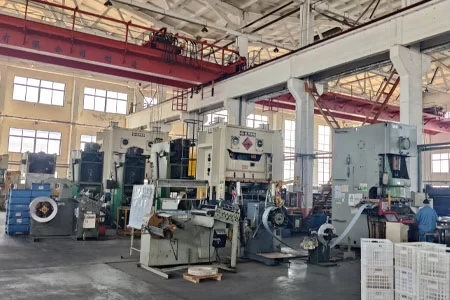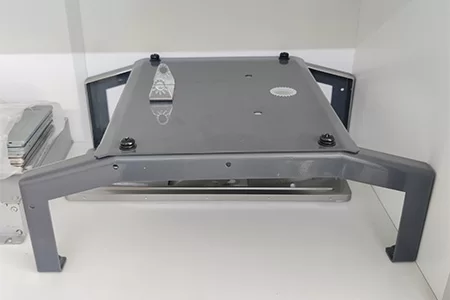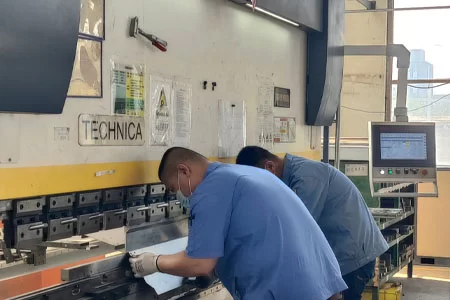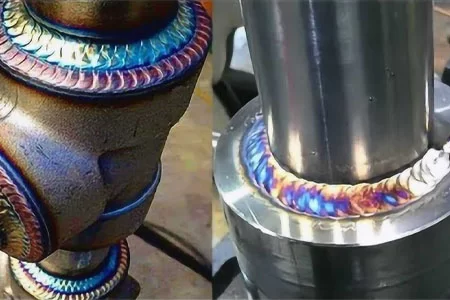Sheet metal spinning is an essential manufacturing process that transforms flat metal blanks into axisymmetric shapes. This guide delves into the principles, types, materials, equipment, applications, advantages, and challenges of spinning.

HULK Metal is An Excellent Sheet Metal Spinning OEM Service Supplier
Comprehensive Guide to Sheet Metal Spinning
-
Home>
-
Blog>
-
Technology>
Comprehensive Guide to Sheet Metal Spinning
Sheet metal spinning is an essential manufacturing process that transforms flat metal blanks into axisymmetric shapes. By combining rotational force and pressure, it produces high-strength, lightweight, and seamless parts for various industries. This guide delves into the principles, types, materials, equipment, applications, advantages, and challenges of spinning.
Introduction to Sheet Metal Spinning
Sheet metal spinning involves placing a metal blank on a spinning mandrel, where a roller tool applies force to mold the blank into a desired shape. Unlike cutting processes, spinning reshapes the material without significant loss, making it an economical choice for creating complex geometries. The process caters to industries like aerospace, automotive, and consumer goods, where precision and durability are paramount.
Principles of Sheet Metal Spinning
The spinning process relies on:
Rotational Force: The mandrel rotates at high speeds, creating centrifugal force.
Tool Pressure: The roller applies localized pressure, gradually shaping the blank.
Work Hardening: The material strengthens as it is deformed, improving durability.
Types of spinning include:
Conventional Spinning: Maintains the blank's thickness while shaping.
Shear Spinning: Reduces thickness in specific areas.
Flow Forming: Extends material length while reducing wall thickness.
Types of Spinning
Manual Spinning:
Operated by skilled artisans.
Suitable for custom or low-volume production.
Offers flexibility but limited precision.
CNC Spinning:
Automated and precise.
Ideal for high-volume, repeatable production.
Handles complex shapes with minimal defects.
Hot Spinning:
Applies heat to improve ductility.
Reduces the risk of cracking in hard-to-form materials.
Cold Spinning:
Performed at room temperature.
Best for ductile materials like aluminum.
Sheet Metal Spinning Process
The sheet metal spinning process involves transforming a flat metal blank into a hollow, axisymmetric shape through controlled rotation and applied pressure. This method, known for its precision and efficiency, requires careful execution to ensure quality and minimize defects. Below is a detailed breakdown of the spinning process:
Preparation
Material Selection:
Choose a metal blank with the required properties (e.g., aluminum for lightweight applications or steel for strength).
Ensure uniform thickness and a clean surface free from impurities or oxides.
Mandrel Design:
Select or fabricate a mandrel that mirrors the final part's shape.
Use durable materials like steel or aluminum alloys for mandrels to withstand the forces during spinning.
Tool Setup:
Install the appropriate roller tools based on the desired geometry and thickness of the part.
Ensure the lathe or spinning machine is calibrated and functioning properly.
Mounting the Blank
Place the metal blank onto the mandrel, ensuring it is centered and securely clamped using the tailstock or other holding mechanisms.
Misalignment at this stage can result in defects like uneven thickness or wrinkling.
Spinning Operation
The spinning operation can be broken down into several stages:
Initial Forming:
The lathe spins the mandrel and blank at high speeds.
The roller tool is brought into contact with the blank, applying pressure to push the metal against the mandrel.
This step creates the basic shape of the part.
Incremental Forming:
The roller makes multiple passes over the blank, gradually shaping it to the mandrel’s contour.
Adjustments to the tool's position and pressure are made to control thickness and curvature.
Trimming (Optional):
Excess material at the edges of the blank is trimmed using a cutting tool for a precise finish.
Advanced Techniques
Shear Spinning:
Involves thinning the material as it stretches over the mandrel.
Commonly used for creating tapered or elongated parts like rocket nose cones.
Hot Spinning:
Metal is heated to enhance ductility, reducing the risk of cracking or tearing.
Suitable for hard-to-form materials like titanium.
Cooling and Stress Relief
Allow the part to cool gradually to prevent thermal distortion.
For metals prone to stress buildup (e.g., stainless steel), annealing may be performed to enhance material properties.
Finishing Operations
Deburring:
Remove sharp edges or burrs caused during spinning.
Polishing:
Achieve a smooth surface finish using abrasive tools or chemical treatments.
Coating (Optional):
Apply protective coatings like anodizing for aluminum or powder coating for steel to enhance durability and aesthetics.
Quality Control
Inspect the part for dimensional accuracy, surface finish, and wall thickness consistency.
Common inspection methods include:
Visual Inspection: Check for surface defects like scratches or dents.
Thickness Measurement: Use calipers or ultrasonic gauges.
Non-Destructive Testing (NDT): Employ X-ray or ultrasonic methods for critical applications.
Automation in Spinning
CNC (Computer Numerical Control) spinning machines streamline the process by automating:
Tool positioning and pressure adjustments.
Mandrel rotations for precise and repeatable results.
Quality control integration with sensors for real-time defect detection.
Materials Used in Sheet Metal Spinning
The choice of material is critical to the success of the sheet metal spinning process. Materials must possess certain properties such as ductility, strength, and thickness uniformity to ensure efficient shaping without defects like cracking or tearing. Below is a detailed exploration of commonly used materials and their suitability for spinning.
Aluminum
Characteristics:
Lightweight: Reduces energy consumption during spinning.
Corrosion-Resistant: Ideal for applications exposed to moisture or chemicals.
Highly Ductile: Easily forms into complex shapes without cracking.
Conductivity: Effective for electrical and thermal components.
Common Alloys:
3000 Series: Excellent corrosion resistance, suitable for cookware and chemical tanks.
5000 Series: High strength and good weldability, often used in marine and automotive parts.
Applications:
Consumer Goods: Lampshades, cooking utensils.
Automotive: Lightweight wheels, fuel tanks.
Tips for Spinning:
Use optimal lubrication to minimize friction and enhance surface finish.
Preheating is often unnecessary due to aluminum’s natural ductility.
Steel
Steel is valued for its strength and versatility, making it a popular choice in industries requiring durability.
Mild Steel:
Economical and easy to form.
Used in automotive frames and industrial parts.
Stainless Steel:
Superior corrosion resistance.
Suitable for food processing equipment and medical devices.
High-Strength Steel:
Enhanced load-bearing capacity.
Used in structural applications and heavy machinery.
Applications:
Construction: Structural brackets and reinforcements.
Food Industry: Containers and tanks.
Industrial Equipment: Pressure vessels and piping.
Tips for Spinning:
Consider preheating high-carbon steel to reduce the risk of cracking.
Use carbide rollers for prolonged tooling life.
Copper and Brass
Copper and brass are favored for their aesthetic appeal, conductivity, and malleability.
Copper:
High electrical and thermal conductivity.
Resistant to corrosion and wear.
Often used in electrical components, cookware, and roofing.
Brass:
An alloy of copper and zinc.
Provides excellent machinability and decorative finishes.
Commonly used in musical instruments, fittings, and ornamental parts.
Applications:
Electronics: Connectors, heat exchangers.
Decorative Elements: Chandeliers, sculptures.
Plumbing: Pipes and fixtures.
Tips for Spinning:
Avoid excessive speed, which can cause heat buildup and oxidation.
Use precise lubrication to maintain a smooth surface finish.
Other Materials
Nickel Alloys:
Excellent for high-temperature applications.
Commonly used in chemical processing and aerospace components.
Magnesium:
Lightweight but less common due to flammability concerns.
Used in niche aerospace and automotive parts.
Exotic Alloys:
Custom alloys for specific industries (e.g., Inconel for turbines).
Key Considerations When Choosing Materials
Ductility: Highly ductile materials are easier to spin into complex shapes.
Thickness: Uniform sheet thickness ensures consistent results.
End-Use Requirements: Consider factors like corrosion resistance, strength, and thermal properties.
Cost: Balance material quality with budget constraints.
Surface Finish Needs: Smooth surfaces may require specific alloys and polishing techniques.
Equipment and Tooling
Key Components:
Mandrel: Supports the blank and determines the final shape.
Roller Tool: Gradually shapes the metal.
Tailstock: Secures the blank during spinning.
Tooling Materials:
Hardened steel or carbide for durability.
Lubricants minimize friction and prevent overheating.
Applications of Sheet Metal Spinning
Automotive:
Wheels, reflectors, and exhaust components.
Offers seamless and precise geometries.
Consumer Goods:
Lampshades, cookware, and musical instruments.
Combines functionality with aesthetic appeal.
Industrial Equipment:
Cylindrical tanks and conical structures.
Used in construction and storage solutions.
Advantages of Sheet Metal Spinning
Sheet metal spinning is renowned for its unique ability to produce high-quality, seamless, and durable components with exceptional material efficiency. Below is an in-depth exploration of the advantages of this manufacturing process:
Material Efficiency
Minimal Waste:
Unlike cutting or machining, spinning reshapes metal without significant removal, reducing scrap.
Scrap material generated, if any, is often recyclable, contributing to cost savings and sustainability.
Thickness Control:
Shear spinning and flow forming allow for precise control of wall thickness, optimizing material usage for lightweight applications.
Cost Reduction:
Efficient use of raw materials reduces production costs, especially for high-value metals like titanium and aluminum.
Cost-Effectiveness
Lower Tooling Costs:
Spinning uses a simple mandrel and roller tool setup, unlike the expensive molds required in stamping or deep drawing.
Suitable for prototyping and small-batch production due to reduced setup expenses.
Short Lead Times:
Minimal tooling and quicker setup result in shorter production times, allowing manufacturers to respond to market demands rapidly.
Economical for Axisymmetric Parts:
Ideal for components like cones, cylinders, and domes, which are challenging to produce with other methods.
Versatility
Wide Material Compatibility:
Suitable for diverse metals including aluminum, steel, brass, copper, and even exotic alloys like titanium and nickel-based alloys.
Complex Geometries:
Capable of producing intricate shapes that would otherwise require multiple manufacturing steps.
Scalable Production:
Manual spinning for custom or low-volume needs and CNC spinning for mass production.
Enhanced Strength
Work Hardening:
The process improves the mechanical properties of the material, such as tensile strength and fatigue resistance.
Seamless Construction:
Eliminates weld seams, reducing weak points and enhancing the overall durability of components.
Superior Surface Finish
Smooth, Polished Appearance:
Roller tools compress the material’s surface during spinning, resulting in a refined finish.
Minimal Post-Processing:
Often eliminates the need for additional polishing or machining, saving time and resources.
Customization Capabilities
Design Flexibility:
Easy to modify designs by changing the mandrel shape, allowing manufacturers to cater to varied specifications.
Prototyping to Mass Production:
Cost-effective for one-off prototypes and scalable for large-scale industrial needs.
Environmental Benefits
Eco-Friendly Process:
Reduced material wastage aligns with sustainability goals.
Energy Efficiency:
Consumes less energy compared to casting or forging, especially in cold spinning processes.
Challenges in Spinning
Thinning and Wrinkling:
Improper tool pressure may cause inconsistent thickness.
Solutions: Use controlled roller paths and optimal force.
Surface Finish:
Friction can cause scratches or blemishes.
Solutions: Use high-quality rollers and appropriate lubrication.
Limitations in Shape:
Restricted to axisymmetric parts.
Advanced CNC tools can overcome some complexity issues.
Comparison with Other Forming Techniques
Sheet metal spinning is distinct from other forming processes like deep drawing, stamping, and roll forming. Understanding the similarities and differences helps manufacturers choose the best method for their specific needs. Below is a detailed comparison across several parameters:
Spinning vs. Deep Drawing
Definition:
Spinning: Forms axisymmetric parts by rotating a metal blank and pressing it against a mandrel.
Deep Drawing: Shapes a metal sheet into a cavity using a punch and die.
Material Usage:
Spinning: Retains material integrity with minimal waste.
Deep Drawing: Generates more scrap, especially in trimming.
Part Complexity:
Spinning: Best for conical, cylindrical, and curved shapes.
Deep Drawing: Suitable for complex, non-symmetric parts like box shapes.
Tooling Cost:
Spinning: Lower tooling costs, especially for small batches.
Deep Drawing: High initial costs due to the requirement of custom dies.
Applications:
Spinning: Ideal for prototypes, aerospace components, and decorative items.
Deep Drawing: Common in automotive fuel tanks, kitchen sinks, and battery housings.
Spinning vs. Stamping
Definition:
Spinning: Utilizes rotational force and gradual deformation to shape the metal.
Stamping: Involves pressing a sheet between a punch and die to create a desired shape.
Speed and Volume:
Spinning: Slower, better for low to medium-volume production.
Stamping: Faster and suited for mass production.
Material Thickness:
Spinning: Accommodates thin and thick sheets.
Stamping: Often requires uniform sheet thickness for consistent results.
Flexibility:
Spinning: Easily adaptable for custom designs.
Stamping: Less flexible; significant costs involved in altering designs.
Applications:
Spinning: Aerospace domes, reflectors, and cookware.
Stamping: Automotive body panels, electronic enclosures, and coins.
Spinning vs. Roll Forming
Definition:
Spinning: Shapes individual parts using a spinning mandrel and roller.
Roll Forming: A continuous process where a metal strip passes through rollers to form profiles.
Process Nature:
Spinning: Produces discrete parts.
Roll Forming: Best for long, continuous profiles like channels and beams.
Precision:
Spinning: High precision for intricate and detailed parts.
Roll Forming: Excellent for consistent cross-sectional profiles but limited in complex geometries.
Tooling and Setup:
Spinning: Quick and low-cost setup for small batches.
Roll Forming: High setup costs, economical only for large-scale production.
Applications:
Spinning: Conical or domed shapes for industrial use.
Roll Forming: Roofing panels, construction frames, and automotive trim.
Spinning vs. Casting
Definition:
Spinning: Mechanically deforms metal sheets into shapes without melting.
Casting: Involves pouring molten metal into molds and solidifying it.
Surface Quality:
Spinning: Produces smooth surfaces with minimal finishing.
Casting: Often requires machining or polishing due to surface imperfections.
Material Utilization:
Spinning: More efficient; no significant material loss.
Casting: Can lead to higher material waste during mold filling and trimming.
Strength:
Spinning: Results in stronger parts due to work hardening.
Casting: Can create brittle parts due to porosity and inclusions.
Applications:
Spinning: Aerospace, automotive components requiring strength and precision.
Casting: Engine blocks, complex machine components, and decorative items.
Spinning vs. Forging
Definition:
Spinning: Shapes sheet metal by rotating and pressing.
Forging: Deforms solid metal using compressive forces.
Strength and Durability:
Spinning: Work hardening improves strength but less robust than forged parts.
Forging: Produces extremely strong and dense components.
Material State:
Spinning: Utilizes metal in sheet form.
Forging: Uses billets or ingots, ideal for dense, solid parts.
Applications:
Spinning: Ideal for lightweight applications like reflectors and domes.
Forging: Best for heavy-duty components like crankshafts and gears.
Choosing the Right Process
Design Complexity:
Opt for spinning when producing seamless, curved shapes.
Choose deep drawing, stamping, or casting for non-symmetric or intricate designs.
Production Volume:
Use stamping or roll forming for mass production.
Spinning excels in low to medium-volume, custom projects.
Material Characteristics:
Spinning handles ductile metals like aluminum and steel efficiently.
Forging and casting are better suited for dense, high-strength alloys.
Budget Constraints:
Spinning has lower initial costs compared to casting or stamping, making it ideal for prototypes or small batches.
Innovations and Trends
Advanced CNC Systems:
Integration with AI for real-time adjustments.
Eco-Friendly Practices:
Recycling metal waste and using energy-efficient machines.
Hybrid Processes:
Combining spinning with welding or deep drawing for multifaceted components.
Tips for Choosing a Spinning Supplier
Experience: Look for expertise in your target industry.
Technology: Ensure access to CNC spinning and high-quality tooling.
Quality Control: Verify adherence to ISO standards.
Scalability: Assess the supplier’s capacity to handle production growth.
Conclusion
Sheet metal spinning is a versatile and efficient manufacturing process that offers precision, durability, and material efficiency. With applications across multiple industries, it continues to evolve, integrating cutting-edge technologies for superior performance.
For your next project, consider partnering with an experienced provider like HULK Metal to leverage advanced spinning techniques and deliver exceptional results.
Article Navigation
Article Navigation
Foundries
-

November.21, 2024
HULK Metal Stamping Factory Show
READ MORE
-

October.29, 2024
Introduction to Sheet Metal Forming: Processes, Materials, and Choosing the Right Partner
READ MORE
-

October.24, 2024
Comprehensive Guide to Sheet Metal Blanking
READ MORE
-

September.30, 2024
Comprehensive Understanding of Sheet Metal Welding
READ MORE






